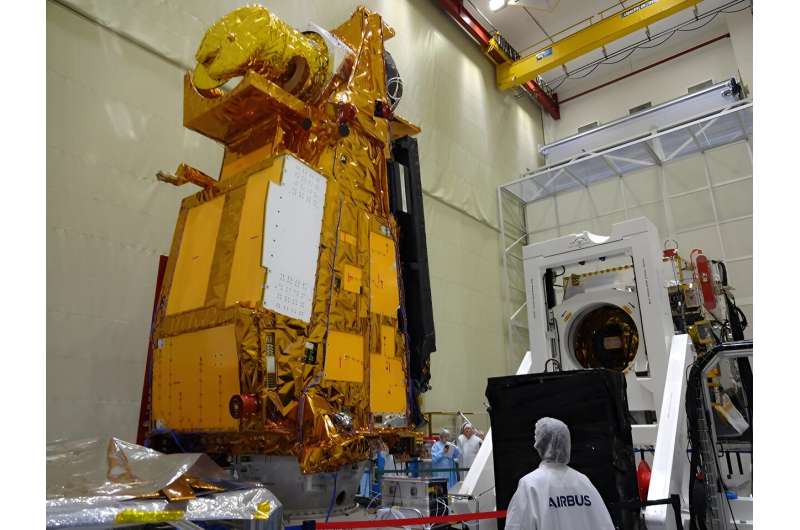This article has been reviewed according to Science X's editorial process and policies. Editors have highlighted the following attributes while ensuring the content's credibility:
fact-checked
proofread
A close-up, on-the-ground view of Europe's next-generation satellites

On Nov. 10, journalists were given an up-close view of two very special spacecraft that will soon empower weather services in Europe with more and higher quality data for weather forecasting.
Metop Second Generation A1 and B1 (Metop-SGA1 and Metop-SGB1) are the first pair of a total of six satellites in the EUMETSAT Polar System—Second Generation (EPS-SG) system.
The first two satellites are undergoing testing and integration of their instruments at the Airbus Defense and Space cleanroom in Toulouse, France. It is anticipated they will be launched in 2025–2026 into their low-Earth, polar orbit, at about 835km altitude.
"The multi-billion euro EPS-SG system will be the main source of data for complex computer modeling used for advanced weather forecasting from 12 hours to 10 days ahead," EUMETSAT's EPS-SG Program Manager Fran Martinez Fadrique said.
"Its new and next-generation instruments will provide more and better data for weather and climate services in Europe until at least the mid-2040s. Studies show they will generate an estimated socio-economic return of 20:1 on our member states' investment through significantly improved weather predictions."
The data from the first-generation Metop satellites have been the single biggest contributor to accuracy of weather forecasts 12 hours to 10 days in advance. The second-generation Metop satellites will provide more, and higher resolution, data, EUMETSAT's EPS-SG Program Scientist Dr. Rosemary Munro said.
"This system, together with the third generation of our geostationary Meteosat satellites, the first of which was launched less than a year ago, will enable a new era of weather forecasting in Europe," Munro said.
"Most importantly, we know the benefits of this crucial space infrastructure will be felt by the citizens in our member states through more accurate and timely weather forecasts which will help save lives and livelihoods.
"The data from this system has many uses beyond weather forecasting. From monitoring wildfires and plumes of volcanic ash, from aiding maritime safety to helping to predict droughts through to monitoring the hole in the ozone layer, these satellites will provide a wealth of data about the Earth system.
"Additionally, the Metop-SGA satellites will carry the European Union's Copernicus Sentinel-5 instrument, which will aid monitoring and prediction of air pollution."
Martinez Fadrique said the EPS-SG system represents a new chapter in an established European success story that has resulted in Europe being a world leader in satellite meteorology.
"This success was possible because of the model of cooperation between EUMETSAT and the European Space Agency (ESA), harnessing European scientific and industrial expertise and the commitment of European industry," he said.
"The requirements for the new satellites are defined by EUMETSAT through consultation with scientists and users of their data, primarily the national meteorological and hydrological services of our 30 member states and the European Center for Medium-Range Weather Forecasts.
"ESA then procures the spacecraft to meet those requirements. These Metop-SG satellites have been developed under ESA contract by a European industrial consortium led by Airbus Defense and Space.
"To operate these spacecraft, and our existing satellites, and to receive, process, disseminate and archive the vastly increased amount of data produced by their instruments, EUMETSAT has developed sophisticated ground systems in high-tech mission control centers at its Darmstadt headquarters."
The EPS-SG system is part of the European-United States' Joint Polar System. Under this arrangement, data from EUMETSAT's and the United States National Oceanic and Atmospheric Administration's (NOAA) polar-orbiting satellites are shared, bringing benefits to weather forecasting and climate monitoring to both sides.
Provided by European Organisation for the Exploitation of Meteorological Satellites (EUMETSAT)





















